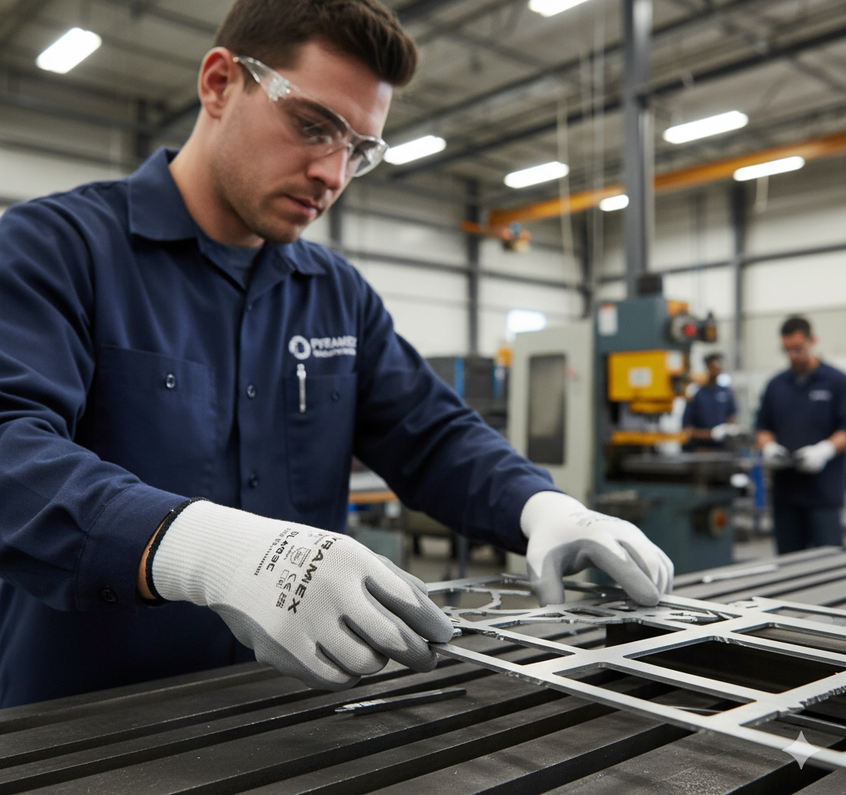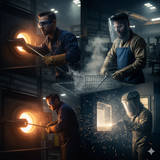The Right Guard: Decoding Cut Resistance and Abrasion Ratings in Safety Gloves
Hands are our most valuable tools, yet hand and finger injuries remain the most frequent type of workplace incident across nearly every industry, from manufacturing and logistics to construction and food service. Many of these injuries—cuts, abrasions, punctures, and lacerations—are completely preventable with the correct glove.
The challenge is that the sheer variety of safety gloves can be overwhelming. Choosing the wrong glove can be just as dangerous as wearing none at all, offering a false sense of security while compromising dexterity.
Effective hand protection requires moving beyond "just a glove" and understanding the specific performance standards that define resistance. At Your Safety Company, we simplify the process by focusing on the science. Here is your essential guide to decoding cut resistance and abrasion ratings using the ANSI/ISEA 105 standard.
Why Cut Resistance is Not Universal
A glove designed for protection against sharp sheet metal will be vastly different from a glove designed for gripping oily components. ANSI/ISEA 105 is the performance standard that objectively rates a glove’s resistance to hazards.
The key to the standard is matching the glove's intended function (measured in grams of cutting force) to the specific hazard (measured in ounces or pounds of force required to cause an injury).
The ANSI/ISEA 105 Cut Resistance Scale
Cut resistance is measured on a scale from A1 to A9. This rating indicates the amount of weight (in grams) required for a sharp blade to cut through the material.
| ANSI Cut Level | Required Cut Load (Grams) | Example Hazard Level | Typical Job Applications |
| A1 | $200 - 499$ | Handling light materials, nuisance cuts | Assembly, automotive maintenance, warehousing |
| A2 | $500 - 999$ | Light duty metal handling, box cutting | General handling, electrical wiring |
| A3 | $1,000 - 1,499$ | Moderate cuts, metal fabrication | Light metal stamping, glass handling (light) |
| A4 | $1,500 - 2,199$ | Higher cut hazards, razor blades | Medium-duty sheet metal, meat processing |
| A5 | $2,200 - 3,399$ | Significant exposure to sharp objects | Auto glass installation, heavy metal stamping |
| A6 - A9 | $3,400$ and up | Extreme hazards (A9: $>6,000$ g) | Demolition, meat butchering, pulp/paper industry, recycling |
Key Takeaway: If your job involves handling razor-sharp sheet metal, you need to be looking at a minimum of an A4 or A5 rated glove, not an A2.
Beyond the Cut: Abrasion, Puncture, and Grip
While cut resistance is often the focus, gloves must also protect against daily wear and tear and provide necessary dexterity.
1. Abrasion Resistance (Wear and Tear)
This rating measures how durable the glove material is when rubbing against rough surfaces.
-
Rating Scale: Rated from 1 to 6, with 6 being the highest resistance.
-
Why it Matters: A glove with high cut resistance but low abrasion resistance will wear out very quickly in high-friction environments (like handling rough concrete or brick). High abrasion resistance improves glove lifecycle cost.
2. Puncture Resistance
This measures the glove’s ability to resist being pierced by sharp, slender objects like needles, wire, or small splinters.
-
Rating Scale: Rated from 1 to 5, with 5 being the highest resistance.
-
Why it Matters: Crucial for waste management, recycling, and handling materials with stray wires or large splinters, though it does not protect against fine hypodermic needles (which require specialized needlestick gloves).
3. Coatings and Grip
The glove's coating is vital for grip and tactile feel:
-
Nitrile (General Purpose): Excellent resistance to punctures and chemicals; provides a very good dry grip.
-
Foam Nitrile: Offers a spongier, more breathable feel and fantastic wet/oily grip by pushing liquids away from the surface.
-
Polyurethane (PU): Extremely thin coating, offering maximum dexterity and tactile sensitivity, best for precision work with low hazard risk.
-
Latex (Natural Rubber): Offers great elasticity and grip but is not suitable for oily environments or workers with latex allergies.
Your Safety Company: Matching the Glove to the Task
Selecting the right safety glove starts with a thorough hazard assessment. You must precisely define the level of cutting force, the amount of abrasion, and the grip required for every task. The right glove protects your workers, improves dexterity, and enhances productivity.
At Your Safety Company, we carry a massive inventory of ANSI/ISEA 105 rated gloves featuring high-performance materials like Kevlar, HPPE, and specialized coatings to meet every A1 to A9 requirement.
Don't let guesswork lead to preventable injury. Visit yoursafetycompany.com today to explore our selection of cut-resistant and specialized safety gloves.
Recent Posts
-
More Than Goggles: The Specialized Eye Protection Needed for High-Heat Industrial Environments
In facilities that process metal at extreme temperatures, eye safety is a complex, multi-layered cha …12th Nov 2025 -
Double Defense: Why Cut and Impact Protection is Critical for Material Handling
In facilities that deal with heavy metal parts, sharp edges, and complex machining, a standard work …11th Nov 2025 -
Beyond the Flame: Why NFPA 2112 FR Apparel is Non-Negotiable
In high-risk industrial settings—from petrochemical plants and utilities to metal processing and hea …7th Nov 2025



